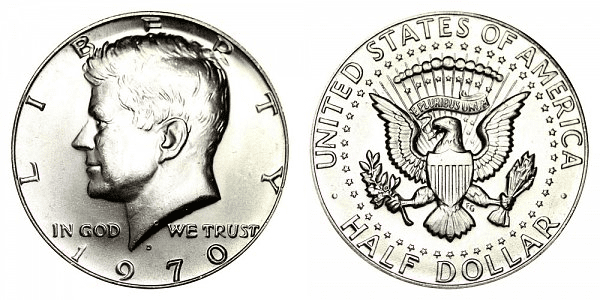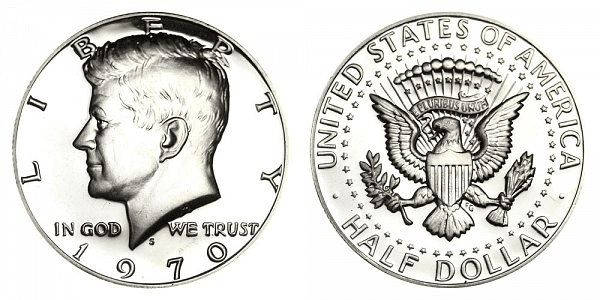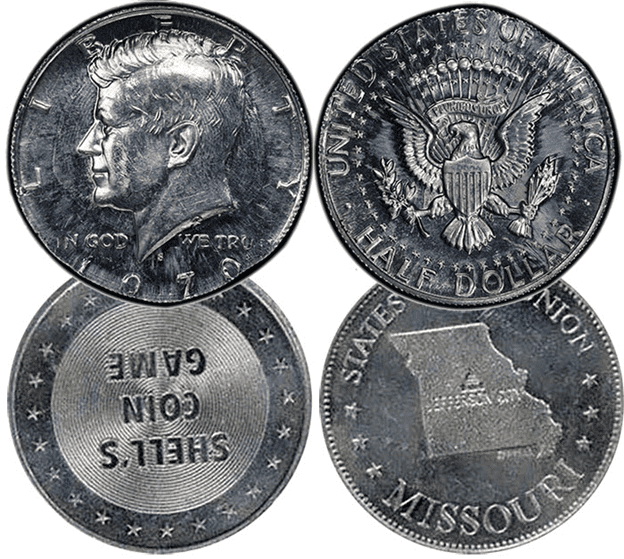What Is The 1970 Kennedy Half Dollar Made Of?
The only Kennedy half designed for circulation that contained any silver at all was the 1970 Kennedy Half Dollar, the last of the regular-strike silver-clad half dollars. Collectors were surprised by its debut because only mint sets were available that year.
Since the United States Mint didn’t make this information widely known, it was too late for collectors to place an order for the brand-new collectable half dollar.
The 1970-D Kennedy half dollar has the lowest mintage of any business strike Kennedy coin until 2006. A total of 2,150,000 mint sets were struck.
Both collectors and non-collectors alike preserve the Kennedy Half Dollar, one of the most well-known and treasured coins honoring one of the most beloved US presidents—John F. Kennedy.
The US Mint sculptors Gilroy Roberts and Frank Gasparro were chosen to execute the work when Congress approved the production of a new half-dollar design to honor John F. Kennedy. Kennedy and the country he served were honored in the final design. The Kennedy half dollar, which is still in circulation today, was first produced in 1964.
John F. Kennedy is depicted in a bust on the coin’s obverse. “LIBERTY” is written along the top, while “IN GOD WE TRUST” is written at the bottom. At the bottom, in the center, is the mintage date.
On its chest, the American bald eagle’s coat of arms is visible, and its wings are extended widely. The eagle’s talons are holding a collection of arrows and an olive branch. The coin’s top is centered with “UNITED STATES OF AMERICA,” while its bottom is centered with “HALF DOLLAR.”
In 1970, the Vietnam War was in full force. Student strikes forced the closure of university campuses, while millions of Americans participated in violent protests at home. Four protesters were shot and killed by National Guard personnel at Kent State University in Ohio.
Is The 1970 Kennedy Half Dollar Silver?
Kennedy half dollars struck in 1970 contain 4.600 grams, or.1479 troy ounces, of.999 pure silver, making them 40% silver. It’s worth noting that this was the last year that Kennedy Half Dollars (outside any special strikes) contained silver.
If the currency was struck in 1969, you can be sure that it contains silver because every Kennedy dollar made in 1970 contains 40% silver. If you really want to be certain, try gazing at the edge of the coin. The cladding on the coin is likely to have worn away and exposed any basic metal underneath because here is where it experiences the most wear.
If copper is present, a reddish-brown streak will be visible on the coin. Instead, you may tell that your Kennedy half dollar is made of silver if you can plainly see a silver stripe.
1970 Kennedy Half Dollar Rarities And Varieties
1970-D Kennedy Half Dollar
Year: 1970
Face Value: $0.50
Composition: 40% silver and 60% copper
Total Weight: 11.50 g
Diameter: 30.6 mm
Thickness: 2.15 mm
Edge: 150 Reeds
Minted in: Denver
Quantity Minted: 2,150,000

1970-S Kennedy Half Dollar
Year: 1970
Face Value: $0.50
Composition: 40% silver and 60% copper
Total Weight: 11.50 g
Diameter: 30.6 mm
Thickness: 2.15 mm
Edge: 150 Reeds
Minted in: San Francisco
Quantity Minted: 2,632,810

1970-P (no mint mark) Kennedy Half Dollar
The Philadelphia mint didn’t strike any Kennedy Half Dollars in the year 1970, meaning that there are no ‘no-mint mark’ Kennedy Half Dollars in circulation.
List of Errors
Proof 1970-S Kennedy Half Dollar Struck on Aluminum Shell Gas Token

This stunning Proof big mint mistake is remarkable. It is a double-struck 1970 Kennedy half dollar on an aluminum Shell Gas token from the San Francisco Mint. As a marketing tool for their gas stations, the Shell Oil Company published a State of the Union coin game booklet in 1969 and 1970. People who gathered all 50 of these state-specific aluminum tokens won rewards.
The US Mint did not produce any aluminum coins for general use. Three of these aluminum Shell tokens were either intentionally stolen in or mixed up in a bin of blank planchets. Additionally, they were either removed from the Mint or showed up in sealed Proof Sets where a fortunate collector found them. Only three of these error coins are currently known to exist.
How Much Is A 1970 Kennedy Half Dollar Worth Today?
In circulated condition, this coin is worth at least its weight in silver. The silver melt value of this coin is $2.69 as of September 7, 2022. This melt value is calculated using the current spot silver price of $18.20 per ounce. Listed below are the average values for the Kennedy Half Dollar, dependent on grade.
| G | VG | F | VF | XF | AU | MS60 | MS65 | Proof | |
| 1970-D | $4.52 | $4.52 | $4.52 | $4.52 | $0.20 | $4.52 | $8.51 | $43 | – |
| 1970-S | – | – | – | – | – | – | – | – | $18 |
How Does The Grading System Work?
The Sheldon Scale is used by numismatists to provide a numerical value to coins. The Sheldon Scale goes from poor (P-1) to perfect mint state (P-1) (MS-70). Coins were originally evaluated using words to reflect their condition (Good, Fair, Excellent, Etc.). Unfortunately, coin collectors and dealers had different ideas about what each of these terms represent.
Professional numismatists joined together in the 1970s and established CoinGrading standards. These numismatists now assign grades at key places on the seventy-point scale, using the most regularly utilized numeric points in conjunction with the original adjective grade. The following are the most common coin grades:
-
-
- (P-1) Poor – Indistinguishable and probably damaged; if used, must have a date and mintmark; otherwise, rather battered.
- (FR-2) Fair – Nearly smooth, but without the damage that a coin graded Poor often possesses. The coin must have enough detail to be identified.
- (G-4) Fair – Inscriptions have merged into the rims in some areas, and important elements have been mostly erased.
- (VG-8) Very Good- A little weathered, but all of the primary design elements are visible, albeit faintly. There is little if any, central detail left.
- (F-12) Good – The item is very worn, yet the wear is even, and the overall design details stand out clearly. Rims are almost completely isolated from the field.
- (VF-20) Very Fine – Moderately weathered, with some finer features still visible. The motto or all letters of LIBERTY are readable. Both sides of the coin have entire rims that are separated from the field.
- (EF-40) Extremely Fine – Gently used; all gadgets are visible, and the most important ones are bold. The finer details are bold and clear, however, light wear may be seen.
- (AU-50) Uncirculated – Slight evidence of wear on the coin’s design’s high points; may have contact marks; eye appeal should be adequate.
- (AU-58) Uncirculated Choice – Slight traces of wear, no severe contact marks, almost full mint shine, and great eye appeal.
- (MS-60) Mint State Basal – Strictly uncirculated; no indication of wear on the coin’s highest points, but an unsightly coin with reduced luster, visible contact marks, hairlines, and other flaws.
- (MS-63) Mint State Acceptable – Uncirculated, but with contact scratches and nicks, little reduced shine, but otherwise appealing appearance. The strike is weak to average.
- (MS-65) Mint State Choice – Uncirculated with great mint shine, very little contact blemishes, and exceptional eye appeal. The strike is unusually severe.
- (MS-68) Mint State Premium Quality – Uncirculated with superb luster, no obvious contact marks to the naked eye, and exceptional eye appeal. The strike is quick and appealing.
- (MS-69) Almost Perfect Mint State – Uncirculated with perfect brilliance, a sharp and appealing strike, and extremely good eye appeal. A near-perfect coin with minor imperfections in the planchet, strike, and contact markings (seen only under 8x magnification).
- (MS-70) Mint State Perfect – Under 8x magnification, there are no tiny imperfections discernible; the strike is crisp, and the coin is perfectly centered on a beautiful planchet. Rarely seen on a coin, this coin is bright and whole, with original luster and exceptional eye appeal.
-
Where To Buy 1970 Kennedy Half Dollar?
The majority of specimens of 1970 Half Dollars are available for purchase and trade on online markets due to the extremely small number of rare or exceptional pieces discovered in this mintage year. You should only think about going to specialty stores, auctions, or dealers like Heritage Auctions if you believe your coin has remarkable qualities.
Check your coin for mint errors such as doubled dies, planchet errors, clipping, and so on.
If you’re unsure ask queries on coin collecting forums like the U.S. Coin Forum if you’re unsure of the rarity of your 1969 half dollar. It is recommended to use services like PCGS to grade your coin.
FAQs
Is a 1970 Kennedy half dollar 40% silver?
Yes, the 1970 Kennedy half dollar represents the last year when the half dollar contained silver.
How rare is a 1970 half dollar?
The business strike (D-mint) was one of the lowest mint numbers seen in the Kennedy Half Dollars’ production. Because of this, 1970-D half dollars are a little more scarce than their counterparts from other years.
Where is the mint mark of 1970 Kennedy half dollar?
The mint mark on a Kennedy half dollar is found below president Kennedy’s neck on the obverse side of the coin.
